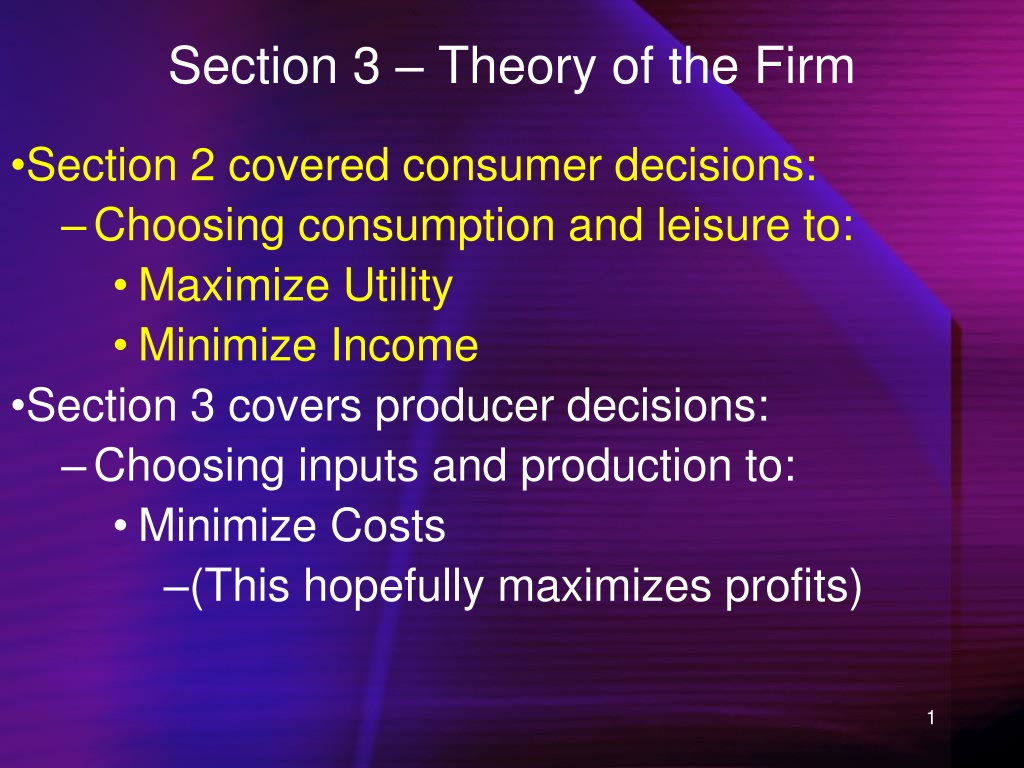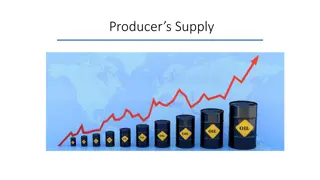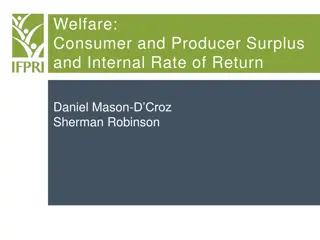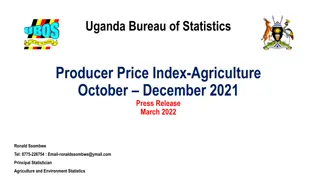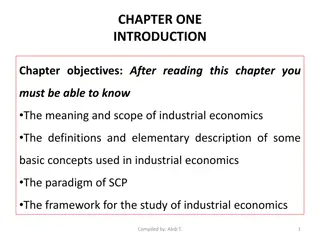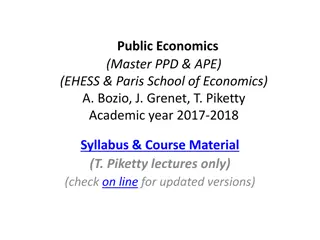Understanding Producer Decisions in Economics
This section delves into the theory of the firm, highlighting how producers make decisions to minimize costs and ultimately maximize profits. It covers topics such as inputs, production functions, cost minimization, and cost curves. By exploring concepts like marginal product, isoquants, and technological progress, readers gain insight into how firms optimize their resources to efficiently transform inputs into outputs.
Download Presentation

Please find below an Image/Link to download the presentation.
The content on the website is provided AS IS for your information and personal use only. It may not be sold, licensed, or shared on other websites without obtaining consent from the author. Download presentation by click this link. If you encounter any issues during the download, it is possible that the publisher has removed the file from their server.
E N D
Presentation Transcript
Section 3 Theory of the Firm Section 2 covered consumer decisions: Choosing consumption and leisure to: Maximize Utility Minimize Income Section 3 covers producer decisions: Choosing inputs and production to: Minimize Costs (This hopefully maximizes profits) 1
Section 3 Theory of the Firm Chapter 6: Inputs and Production Functions Chapter 7: Costs and Cost Minimization Chapter 8: Cost Curves 2
Chapter 6: Inputs and Production Functions Consumer Theory Goods Utility Theory of the Firm InputsProduction Profits 3
Chapter 6: Inputs and Production Functions This chapter will cover: 6.1 Inputs and Production 6.2 Marginal Product (similar to marginal utility) 6.3 Average Product 6.4 Isoquants (similar to indifference curves) 6.5 Marginal rate of technical substitution (MRTS, similar to MRS) 6.6 Special production functions (similar to special utility functions) 6.7 Technological Progress 4
6.1 Inputs and Production Inputs: Productive resources, such as labor and capital, that firms use to manufacture goods and services (also called factors of production) Output: The amount of goods and services produced by the firm Production:transforms inputs into outputs Technology: determines the quantity of output possible for a given set of inputs. 5
More Terms Production function: tells us the maximum possible output that can be attained by the firm for any given quantity of inputs. Q = f(L,K,O) Computer Chips = f1(L,K) Econ Mark = f2(Intellect, Study, Bribe) (Labour, Capital, Other variables) 6
Production and Utility Functions In Consumer Theory, GOODS produce UTILITY: U=f(kraft dinner, hot dogs) In Production Theory, use of INPUTS produce OUTPUTS: Q=f(Labour, Capital, Technology) 7
Production Function Notes A technically efficient firm makes the maximum possible output from its inputs (using available technology) A technically inefficient firm makes less than the maximum possible output from its inputs (using available technology) 8
Notes on the Production Function production set : all points on or below the production function Note: Capital refers to physical capital (goods that are themselves produced goods) and not financial capital (money). 9
Q Example: The Production Function and Technical Efficiency Production Function Q = f(L) D C Inefficient point B Production Set L 10
Causes of technical inefficiency: 1) Shirking -Workers don t work as hard as they can -Can be due to laziness or a union strategy 2) Strategic reasons for technical inefficiency -Poor production may get government grants -Low profits may prevent competition 3) Imperfect information on best practices -inferior technology 11
Example: Acme medical equipment faces the production function: Q=K1/2L1/2 Given labour of 10 and capital of 20, is Acme producing efficiently by producing 12 units? What level of production is technically efficient? 12
Example: Q =K1/2L1/2 =201/2101/2 =14.14 Acme is not operating efficiently by producing 12 units. Given labour of 10 and capital of 20, Acme should be producing 14.14 units in order to be technically efficient. 13
6.2 Marginal Product The production function calculates TOTAL PRODUCT Marginal Product of an input: the change in output (total product) that results from a small change in an input holding the levels of all other inputs constant. MPL = Q/ L (holding constant all other inputs) MPK = Q/ K (holding constant all other inputs) 14
Marginal Utility and Marginal Product In Consumer Theory, marginal utility was the slope of the total utility curve In Production Theory, marginal product is the slope of the total product curve: 15
Q L MPL increasing MPL becomes negative MPL MPL decreasing L 16
Law of Diminishing Returns Law of diminishing marginal utility:marginal utility (eventually) declines as the quantity consumed of a single good increases. Law of diminishing marginal returnsstates that marginal products (eventually) decline as the quantity used of a single input increases. Usually the first few inputs are very productive, but additional units are less productive (ie: programmers working in a small room) 17
Q Example: Production as workers increase Each Additional worker Is less productive Each Additional worker Decreases Production Each Additional worker Is equally productive Each Additional worker Is more productive Total Product L 18
6.3 Average Product Average product: total output that is to be produced divided by the quantity of the input that is used in its production: APL = Q/L APK = Q/K Example: Q=K1/2L1/2 APL = [K1/2L1/2]/L = (K/L)1/2 APK = [K1/2L1/2]/K = (L/K)1/2 19
Marginal, and Average Product When Marginal Product is greater than average product, average product is increasing -ie: When you get an assignment mark higher than your average, your average increases IF MP > AP, AP increasing 20
Marginal, and Average Product When Marginal Product is less than average product, average product is decreasing -ie: When you get an assignment mark lower than your average, your average decreases IF MP < AP, AP decreasing Average Product is maximized when it equals Marginal Product 21
Q L APL increasing APL decreasing APL MPL APL maximized APL L 22 MPL
6.4 Isoquants Isoquant: traces out all the combinations of inputs (labor and capital) that allow that firm to produce the same quantity of output. Example: Q = 4 ?? What is the equation of the isoquant for Q = 40? 40 = ?? => 100 = KL => K = 100/L 23
and the isoquant for any Q? Q = 4 ?? Q2 = 16KL K = Q2/16L 24
K Example: Isoquants All combinations of (L,K) along the isoquant produce 40 units of output. Q = 40 Q = 20 Slope= K/ L L 0 25
Indifference and Isoquant Curves In Consumer Theory, the indifference curve showed combinations of goods giving the same utility The slope of the indifference curve was the marginal rate of substitution (MRT) In Production Theory, the isoquant curve shows combinations of inputs giving the same output The slope of the isoquant curve is the marginal rate of technical substitution (MRTS): 26
6.5 Marginal Rate of Technical Substitution (MRTS) Marginal rate of technical substitution (labor for capital): measures the amount of K the firm the firm could give up in exchange for an additional L, in order to just be able to produce the same output as before. Marginal products and the MRTS are related: MPL/MPK = - K/ L = MRTSL,K 27
Marginal Rate of Technical Substitution (MRS) MP L MP + = Q K L K = since MP - but Q isoquant the along moves one as 0 MP curve, = L K L K K MP = L MP output constant L K K MP = = MRTS L MP output constant , L K L 28 K
The marginal rate of technical substitution, MRTSL,K tells us: The amount capital can be decreased for every increase in labour, holding output constant OR The amount capital must be increased for every decrease in labour, holding output constant -as we move down the isoquant, the slope decreases, decreasing the MRTSL,K -this is diminishing marginal rate of technical substitution -as you focus more on one input, the other input becomes more productive 29
MRTS Example Let Q=4LK MPL=4K MPK=4L Find MRTSL,K MRTSL,K = MPL/MPK MRTSL,K =4K/4L MRTSL,K =K/L 30
Isoquants Regions of Production Due to the law of diminishing marginal returns, increasing one input will eventually decrease total output (ie: 50 workers in a small room) When this occurs, in order to maintain a level of output (stay on the same isoquant), the other input will have to increase This type of production is not economical, and results in backward-bending and upward sloping sections of the isoquant: 31
K Example: The Economic and the Uneconomic Regions of Production Isoquants MPK < 0 Uneconomic region Q = 20 MPL < 0 Economic region Q = 10 L 0 32
Isoquants and Substitution Different industries have different production functions resulting in different substitution possibilities: ie: In mowing lawns, hard to substitute away from lawn mowers In general, it is easier to substitute away from an input when it is abundant This is shown on the isoquant curve 33
MRTSL,K is high; labour is scarce so a little more labour frees up a lot of capital K MRTSL,K is low; labour is abundant so a little more labour barely affects the need for capital 34 L
MRTS Example Let Q=4LK MPL=4K MPK=4L MRTSL,K =K/L Show diminishing MRTS when Q=16. When Q=16, (L,K)=(1,4), (2,2), (4,1) MRTS(1,4)=4/1=4 MRTS(2,2)=2/2=1 MRTS(4,1)=1/4 35
K MRTSL,K =4 4 MRTSL,K =1 MRTSL,K =1/4 2 1 Q=16 36 L 1 2 4
When input substitution is easy, isoquants are nearly straight lines K When input substitution is hard when inputs are scarce, isoquants are more L-shaped 170 130 100 37 L 55 100
Returns To Scale How much will output increase when ALL inputs increase by a particular amount? RTS = [% Q]/[% (all inputs)] 1% increase in inputs => more than 1% increase in output, increasing returns to scale. 1% increase in inputs => 1% increase in output constant returns to scale. 1% increase in inputs => a less than 1% increase in output, decreasing returns to scale. 38
Example 1: Q1 = 500L1+400K1 Q1 * = 500( L1)+400( K1) Q1*= 500L1+ 400K1 Q1*= (500L1+400K1) Q1*= Q1 So this production function exhibits CONSTANT returns to scale. Ie: if inputs double ( =2), outputs double. 39
Example 2: Q1 = AL1K1 Q2 = A( L1) ( K1) = + AL1 K 1 = + Q1 so returns to scale will depend on the value of + . + = 1 CRS + <1 DRS + >1 IRS 40
Returns To Scale Why are returns to scale important? If an industry faces DECREASING returns to scale, small factories make sense -It is easier to have small firms in this industry If an industry faces INCREASING returns to scale, large factories make sense -Large firms have an advantage; natural monopolies 41
Notes: The marginal product of a single factor may diminish while the returns to scale do not Marginal product deals with a SINGLE input increasing, while returns to scale deals with MULTIPLE inputs increasing Returns to scale need can change as output changes 42
6.6 Special Production Functions 1. Linear Production Function: Q = aL + bK MRTS constant Constant returns to scale Inputs are PERFECT SUBSTITUTES: -example: two 5 TB hard drives is equal to one 10TB hard drive 43
K Example: Linear Production Function Q = Q1 Q = Q0 L 0 44
Special Production Functions -ie: 2 pieces of bread and 1 piece of cheese make a grilled cheese sandwich: Q=min (c, 1/2b) 45
Cheese Example: Fixed Proportion Production Function 2 Q = 2 Q = 1 1 0 Bread 2 4 46
Special Production Functions 3.Cobb-Douglas Production Function: Q = aL K if + > 1 then IRTS if + = 1 then CRTS if + < 1 then DRTS smooth isoquants MRTS varies along isoquants 47
K Example: Cobb-Douglas Production Function Q = Q1 Q = Q0 0 L 48
6.8 Technological Progress Definition: Technological progress shifts isoquants inward by allowing the firm to achieve: more output from a given combination of inputs OR the same output with fewer inputs : Example = Originally : Q 2 L K = After : Q 4 L K 49
Example: technological progress K Q = 100 before Q = 100 after L 50
